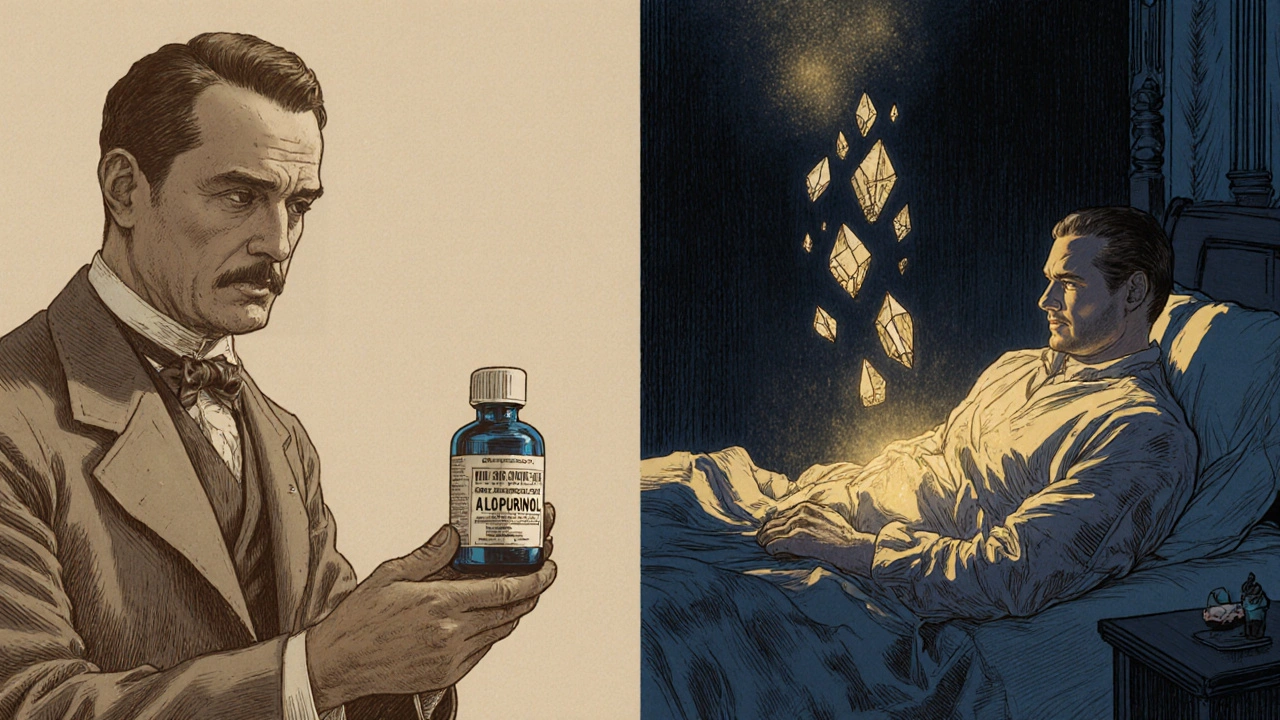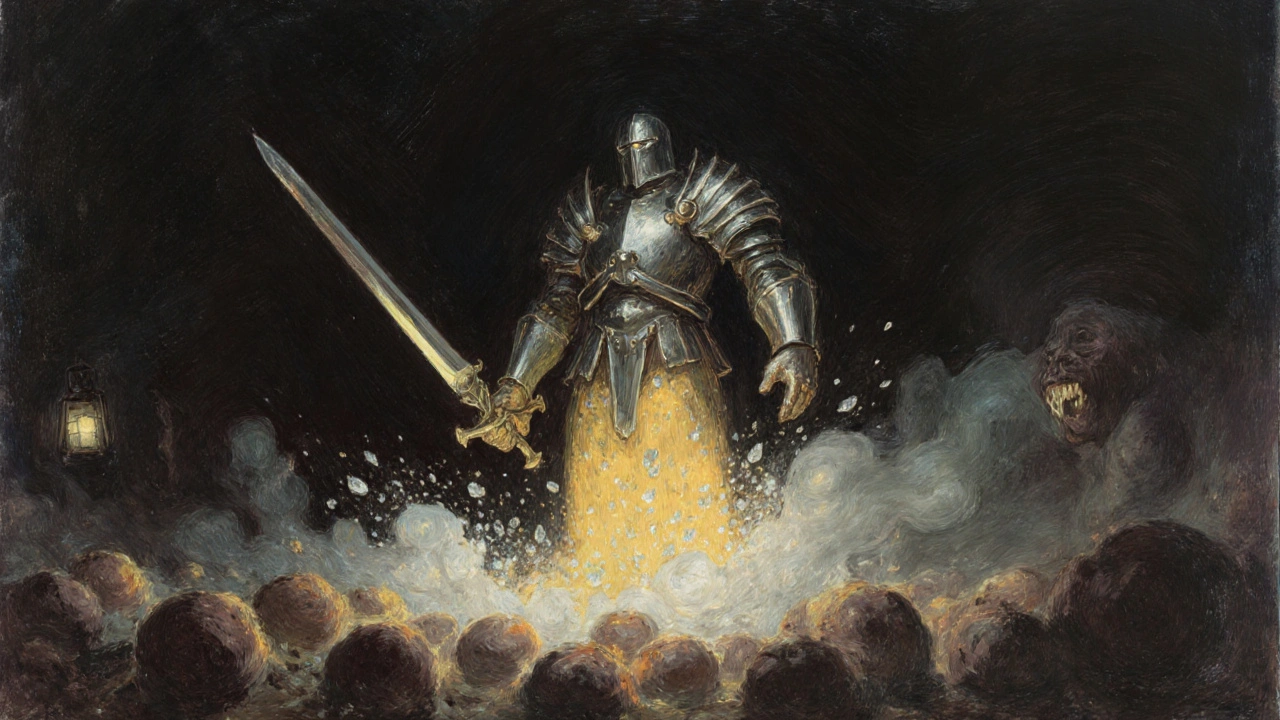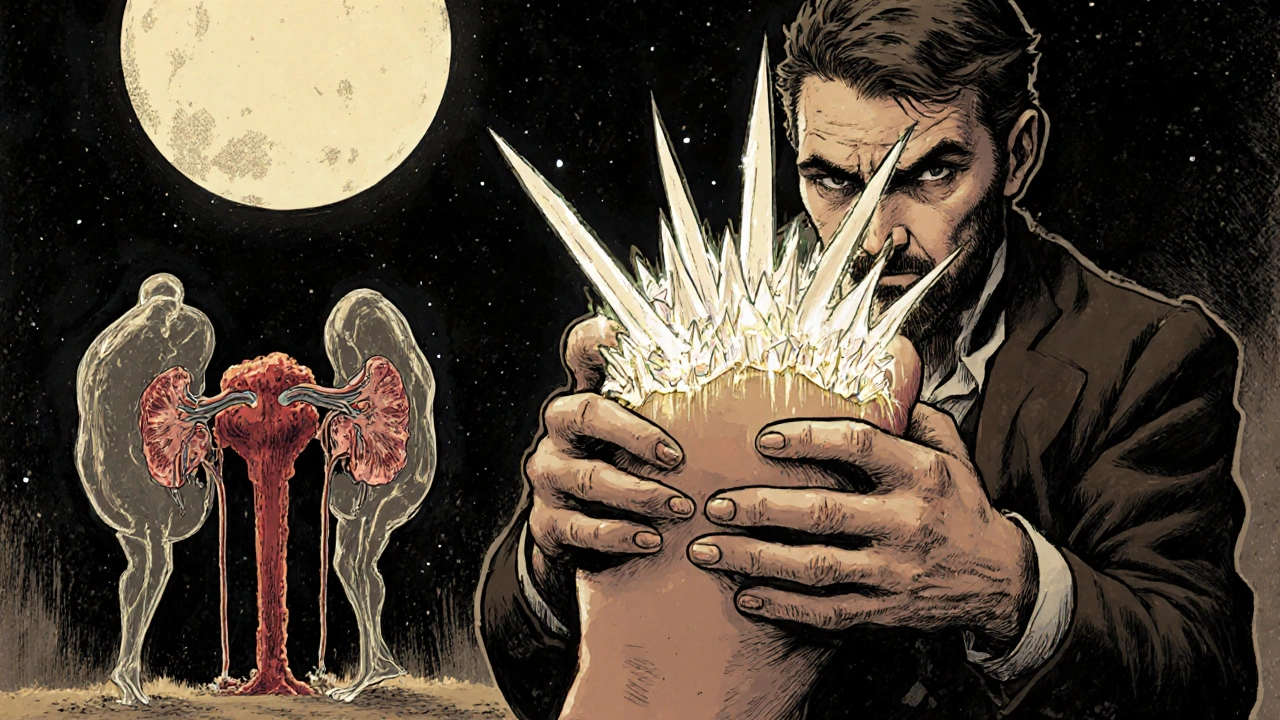When your big toe suddenly swells up, burns like fire, and makes even a bedsheet feel unbearable, you’re not just having a bad night-you’re experiencing gout. It’s not just pain. It’s your body’s immune system going to war with crystals formed from uric acid, a waste product that shouldn’t be building up in the first place. And it all starts with how your body handles purine metabolism.
What Happens When Purines Go Wrong?
Purines are natural compounds found in your cells and in many foods. When your body breaks them down, uric acid is the final product. Most people handle this just fine-the kidneys filter it out, and it leaves the body through urine. But in gout, something breaks down. About 90% of people with high uric acid levels have kidneys that just don’t excrete enough. The rest overproduce it. Either way, uric acid builds up past 6.8 mg/dL-the point where it starts turning into sharp, needle-like crystals in joints. These crystals trigger inflammation, swelling, and the worst kind of pain you can imagine. It’s not a myth. It’s biochemistry. Humans lost the enzyme that breaks down uric acid 15-20 million years ago. That’s why we’re the only primates who get gout. We don’t have a backup system. If your body makes too much or can’t flush it out, you’re at risk.Why Uric Acid Levels Matter More Than You Think
A single blood test showing uric acid above 7.0 mg/dL doesn’t mean you have gout-but it does mean you’re in danger. Data from the NHANES survey shows that at levels below 6 mg/dL, only 0.7% of people develop gout. At 9 mg/dL or higher? Nearly 28% do. The goal isn’t just to feel better after a flare. It’s to get your uric acid below 6.0 mg/dL long-term. For people with tophi (those visible lumps of uric acid crystals under the skin), the target is even lower: 5.0 mg/dL. That’s not a suggestion. It’s medical necessity. Studies show that if you stay under 6.0, crystals begin to dissolve. Flares drop off. Joint damage stops. Yet, only 37% of gout patients in the U.S. ever reach that target. Why? Most doctors start a low dose of medication and never increase it. Patients stop taking it because they feel fine. And no one tells them: you don’t treat gout when it flares-you treat it every day, for life.The Three Types of Urate-Lowering Medications
There are three main classes of drugs used to lower uric acid. Each works differently. And each has trade-offs.1. Xanthine Oxidase Inhibitors (XOIs)
These are the first-line drugs for almost everyone. They block the enzyme xanthine oxidase, which turns purines into uric acid. Two main drugs here: allopurinol and febuxostat. Allopurinol has been around since 1966. It’s cheap-generic versions cost under $5 a month. But most people get started on 100 mg a day, which is barely enough. Studies show that 92% of patients reach target uric acid levels when the dose is increased to 300 mg or higher. Yet, doctors rarely do this. They fear side effects. But the truth? Most rashes are mild. Severe reactions are rare-especially if you’re not of Asian descent (where a genetic marker, HLA-B*58:01, increases risk). Febuxostat works the same way but is stronger. At 80 mg a day, it hits target levels in nearly 67% of patients. But it comes with a black box warning from the FDA. The CARES trial found a higher risk of heart-related death compared to allopurinol. So if you have heart disease, allopurinol is safer. If you can’t tolerate allopurinol or have severe kidney disease, febuxostat may be your only option.2. Uricosurics
These drugs tell your kidneys to dump more uric acid out. Probenecid is the classic one. It works well-if your kidneys are healthy. But if your creatinine clearance is below 50 mL/min, it’s useless and risky. It’s also not strong enough on its own for most people with advanced gout. Lesinurad was approved in 2015 and could boost uric acid lowering when paired with allopurinol. But it was pulled from the market in 2019 because it caused serious kidney damage. Now, new drugs like verinurad are in late-stage trials, aiming to do the same thing but safer.3. Uricase Agents
Pegloticase is the nuclear option. It’s an IV infusion given every two weeks. It doesn’t just lower uric acid-it converts it into allantoin, a harmless substance your body easily flushes out. In trials, it dissolved tophi in 42% of patients within six months. But it’s not for everyone. It costs over $16,000 a month. Insurance fights it. You need pre-authorization. And 26% of people have severe allergic reactions during the infusion. You have to be pre-medicated with steroids and antihistamines. It’s only for people with severe, treatment-resistant gout who have failed everything else.
What About Diet?
You’ve heard it a thousand times: avoid beer, shellfish, and organ meats. And yes, that helps. A plate of liver has up to 400 mg of purines. Anchovies? 500 mg per 100 grams. Beer? It’s not just alcohol-it’s high in purines too. But here’s the catch: diet alone lowers uric acid by maybe 1-2 mg/dL. That’s not enough to get you to target if you’re at 9 or 10. So yes, cut back on red meat and binge-drinking. But don’t think changing your diet will cure gout. It’s support, not treatment.The Real Problem: Getting Patients to Stay on Treatment
Here’s the uncomfortable truth: most people stop their medication within a year. Why? - They feel fine after a flare. So they think they’re cured. - They get a rash or stomach upset and quit without telling their doctor. - They’re told to take it daily, but no one explains why it takes months to work. - They’re scared of side effects-or the cost. A 2022 survey found that 61% of patients quit ULT within 12 months. The biggest reason? They didn’t believe it was working. But here’s what they didn’t know: when you start a urate-lowering drug, you’re more likely to have flares at first. That’s because dissolving crystals irritates the joint. That’s not the drug failing-it’s the body reacting. That’s why guidelines say: start colchicine (0.6 mg daily) at the same time as your uric acid drug. Keep it going for at least six months. That cuts flare risk by 70%.
What’s Next for Gout Treatment?
New drugs are coming. Verinurad, a smarter uricosuric, is in Phase III trials. Arhalofenate, a dual-action drug that lowers uric acid and reduces inflammation, showed promise in 2024. And researchers are looking at genetic markers like SLC2A9 variants to predict who responds best to which drug. But the biggest gap isn’t science-it’s access. In Australia, the U.S., and Europe, allopurinol is affordable. But febuxostat and pegloticase? Out of reach for many. In China, where 23.7 million people have gout, most still don’t get diagnosed-or treated properly.What You Should Do Right Now
If you have gout:- Get your serum uric acid tested. Know your number.
- Ask your doctor: "What’s my target?" (It should be under 6.0 mg/dL.)
- If you’re on allopurinol and it’s not working, ask if you can increase the dose. Don’t stop.
- Start colchicine if you haven’t already-especially in the first six months.
- Don’t rely on diet alone. Medication is non-negotiable.
- If you have tophi or frequent flares, ask about pegloticase. It’s not a last resort-it’s a life-changer.
Frequently Asked Questions
Can gout be cured with diet alone?
No. While reducing purine-rich foods like liver, anchovies, and beer can lower uric acid by 1-2 mg/dL, that’s rarely enough to reach the target of 6.0 mg/dL or lower. Diet helps, but it’s not a substitute for medication in people who already have gout or consistently high uric acid levels.
Why do I have more flares when I start taking allopurinol?
When uric acid drops, crystals begin to dissolve. This releases fragments that trigger inflammation-so flares can happen in the first few months. That’s why guidelines recommend taking colchicine daily for at least six months when starting urate-lowering therapy. It’s not a sign the drug isn’t working-it’s a normal part of the process.
Is febuxostat safer than allopurinol?
No-not for everyone. Febuxostat is more effective at lowering uric acid, but the FDA issued a black box warning in 2019 after a study found a higher risk of heart-related death compared to allopurinol. It’s generally reserved for people who can’t tolerate allopurinol or have severe kidney disease. If you have heart disease, allopurinol is the safer choice.
How often should I get my uric acid checked?
When you start or change your dose, check every 2-5 weeks until your level is stable and below 6.0 mg/dL. Once you’re there, check every 6 months. Many doctors don’t follow this, but it’s critical. You can’t manage what you don’t measure.
What’s the cheapest effective treatment for gout?
Generic allopurinol is the most cost-effective option, costing less than $5 a month. But effectiveness depends on dosing. Most people need at least 300 mg daily to reach target. If you’re still having flares on 100 mg, ask your doctor to increase it-not switch drugs.
Can I stop taking urate-lowering medication if I haven’t had a flare in years?
No. Stopping medication allows uric acid to rise again, and crystals will reform. Even if you’ve been flare-free for years, stopping treatment puts you at high risk of returning flares and permanent joint damage. Gout is a chronic condition that requires lifelong management.


Nicole M
November 12, 2025 AT 03:22This article finally explained why my uncle’s big toe looks like a swollen grape after beer night. I never realized it was crystal buildup, not just "bad luck."
Arpita Shukla
November 13, 2025 AT 20:45Interesting how humans lost the uricase enzyme. Makes you wonder if evolution just forgot to update the code. I mean, we got opposable thumbs but no backup for gout? Poor design.
Benjamin Stöffler
November 14, 2025 AT 02:06Let me be clear: the notion that diet alone can "cure" gout is not merely incorrect-it’s dangerously misleading. Purine reduction yields a 1–2 mg/dL drop-barely a dent in the face of a 9.5 mg/dL baseline. The real villain? Medical inertia. Physicians prescribe 100 mg allopurinol and call it a day-then wonder why patients remain in agony. This is not medicine. It’s negligence dressed in white coats.
And let’s not pretend febuxostat is a villain. The CARES trial had confounding variables-cardiovascular comorbidities weren’t stratified properly. The real issue? Underdosing. Allopurinol at 300 mg? Effective. At 100 mg? A placebo with side effects.
Colchicine prophylaxis is non-negotiable. Yet, 80% of primary care docs don’t prescribe it. Why? Because they don’t read guidelines. They Google. And Google doesn’t know the difference between a flare and a cure.
And don’t get me started on insurance. Pegloticase? $16,000/month? In a country that spends $4.5 trillion on healthcare, we can’t afford to dissolve tophi? We’d rather pay for amputations. That’s not economics. That’s moral failure.
Genetics matter. HLA-B*58:01 isn’t a footnote-it’s a warning label. But screening? Rare. Why? Because it’s cheaper to treat the crisis than prevent it.
And yes-gout is lifelong. You don’t "get better." You manage. Like diabetes. Like hypertension. But somehow, we treat gout like a party trick. "Oh, you had a flare? Don’t eat shrimp next time."
The real tragedy? Patients stop meds because they feel fine. But gout doesn’t care how you feel. It’s waiting. Crystallizing. Eroding. And when it strikes again? It’s worse.
We need education. Not just for patients. For doctors. For insurers. For Congress. This isn’t a footnote in rheumatology. It’s a public health emergency.
And if you think you’re "too young" for gout? You’re wrong. The average age of onset is dropping. Thanks to processed food, fructose, and soda.
So yes-cut the beer. Eat less liver. But please-take your pills. Even if you feel fine. Especially then.
Mark Rutkowski
November 15, 2025 AT 13:10It’s wild how something so ancient-crystals forming in your joints-feels so futuristic in its science. We’re talking about a disease that’s been around since pharaohs, and now we’ve got IV drugs that turn uric acid into harmless goo. Nature gave us a broken system, but we’re building a fix. That’s not just medicine-it’s poetry.
And the fact that we’ve outlived our own enzyme? That’s evolution’s quiet joke. We traded uricase for something else-maybe antioxidants, maybe longevity-but now we pay the price with swollen toes. We’re the only primates who get gout because we’re the only ones who lived long enough to break down.
It’s a reminder: biology doesn’t care if you’re smart. It just responds to chemistry. And if you ignore the numbers, your body will remind you-with fire.
Ryan Everhart
November 16, 2025 AT 08:17So you’re telling me the cure is cheaper than my monthly Netflix subscription? And I’ve been avoiding it because I "felt fine"? Thanks for the guilt trip, doc.
David Barry
November 17, 2025 AT 11:13Let’s be real: 92% of patients hit target at 300mg allopurinol? That’s not a success rate-it’s a indictment of lazy prescribing. If your first-line treatment fails 9 out of 10 times at standard dose, maybe the standard dose is the problem. Not the drug.
And the fact that insurance won’t cover pegloticase unless you’ve failed everything else? That’s not risk management. That’s bureaucratic cruelty. People lose joints waiting for approval.
Also-lesinurad got pulled for kidney damage? But verinurad is in Phase III? That’s not innovation. That’s rebranding failure.
And don’t get me started on the "diet helps" myth. It’s like telling a diabetic to eat less cake and calling it treatment.
Alyssa Lopez
November 18, 2025 AT 08:11ALLOPURINOL IS THE ONLY REAL TREATMENT. ANYONE WHO SAYS DIFFERENT IS A BIG PHARMA SHEEP. I SAW A DOCTOR IN TEXAS WHO SAID FEBUXOSTAT WAS "BETTER"-BUT HE WAS PROBABLY ON THE PAYROLL. GOUT IS A LIFESTYLE DISEASE. STOP BLAMING THE DRUGS. START BLAMING THE BEER.
Alex Ramos
November 19, 2025 AT 08:03Just started allopurinol last month. Felt like a war zone the first 3 weeks-flares every other day. Thought I’d made it worse. Then my rheum doc said: "That’s the crystals dissolving." Started colchicine. Now? Zero flares in 4 months. I didn’t know it was supposed to get worse before it got better. Seriously-this info saved me. Thank you.
And yes-I’m still taking it. Even though I feel fine. Even though I miss my IPA. But my toes don’t scream anymore. Worth it.
edgar popa
November 19, 2025 AT 14:10My grandpa had gout. Took allopurinol till he died at 92. Never had a flare after 6 months. He said: "It’s not a cure, kid. It’s a daily rent payment on your joints."
Eve Miller
November 19, 2025 AT 16:50There is a fundamental error in your statement: "diet alone lowers uric acid by maybe 1–2 mg/dL." The word "maybe" is scientifically imprecise and undermines the credibility of your entire argument. Studies show a consistent reduction of 1.0–1.8 mg/dL in controlled trials. Precision matters.
Chrisna Bronkhorst
November 19, 2025 AT 19:53Why are we still using 1960s drugs? Allopurinol was invented when Nixon was president. We’ve put men on the moon but still treat gout like it’s 1966? The system is broken. We need innovation-not dosing adjustments on a 60-year-old molecule.
Amie Wilde
November 20, 2025 AT 22:30My doctor never told me to take colchicine with allopurinol. I thought I was being "strong" by not taking extra pills. Ended up in ER with my worst flare ever. Now I take it. Every day. No regrets.
Esperanza Decor
November 22, 2025 AT 14:00I used to think gout was just for old guys who drank too much. Then I got it at 34. I eat kale. I run 5Ks. I don’t eat liver. So why me? Turns out-my kidneys just don’t filter well. And my genes don’t care how healthy I am. This article didn’t just explain my pain-it gave me back my life.
Deepa Lakshminarasimhan
November 24, 2025 AT 13:17Did you know the FDA approved febuxostat after a 3-month trial? And the heart death risk was buried in a footnote? I think they’re hiding something. Maybe it’s the glyphosate. Or the fluoridated water. Or the fact that Big Pharma owns the FDA. I’ve been taking cherry extract and apple cider vinegar. No flares in 8 months. Coincidence? I think not.